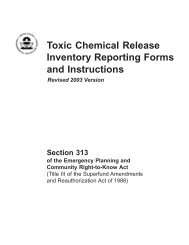Ergonomic Guidelines for Nursing Homes - Seton Resource Center
Ergonomic Guidelines for Nursing Homes - Seton Resource Center
Ergonomic Guidelines for Nursing Homes - Seton Resource Center
You also want an ePaper? Increase the reach of your titles
YUMPU automatically turns print PDFs into web optimized ePapers that Google loves.
designed the new beds to lift from the floor to a height of about 30 inches in 20 seconds.<br />
In addition, these fast beds were designed so that residents would be less likely to slide to<br />
the foot of the bed as they were raised to a sitting position. As a result, residents would<br />
not need to be repositioned. Also, the beds could be used with a gait-belt <strong>for</strong> ambulatory<br />
residents to assist them from a sitting to a standing position.<br />
About three years after Wyandot began its ergonomics ef<strong>for</strong>t, the nursing home<br />
received a grant from the OBWC Division of Safety and Hygiene through an ergonomic<br />
emphasis program to deal with cumulative trauma disorders. The grant enabled<br />
Wyandot’s administrator to purchase 58 fast electric beds, a turning point <strong>for</strong> staff<br />
acceptance. When the first ceiling lifts were installed seven months later, employees<br />
were ready to use them.<br />
One nursing assistant, who has been with Wyandot <strong>for</strong> 19 years, explained why<br />
she liked the new beds so much. “We can quickly bring the bed up to our work height<br />
with a push of a button and we can reposition a resident . . . with ease without stooping or<br />
struggling.”<br />
The final phase of Wyandot's program began with the introduction of the ceiling<br />
lifts. Wyandot’s administrator evaluated several ceiling lift systems. Wyandot chose a<br />
system with a motorized lift and a ceiling mounted track. Tracks were retrofitted into the<br />
rooms at a cost of about $12,000 <strong>for</strong> two double rooms and one bathroom. The first<br />
double room had a track that extended into the bathroom. However, newer systems used<br />
a transfer between the room and bathroom, which simplified the system and reduced<br />
costs.<br />
Providing Training<br />
As Wyandot purchased and installed new equipment, workers received training<br />
on how to use it, and guidelines <strong>for</strong> equipment use were put into place. An LPN inservice<br />
director did the training. New employees learn how to use the devices and know<br />
where to go <strong>for</strong> further instruction or help. Eventually, most of the nursing assistants<br />
adapted to the mechanical lifts and refused to use any other lifting techniques.<br />
Providing Management Support<br />
Wyandot’s administrator took a personal interest in ergonomic issues. To address<br />
high injury and turnover rates at Wyandot, he remained committed to identifying and<br />
solving problems. For example, on one occasion the staff said that the lifts were not easy<br />
to roll on the floors in the B- and C-Wings. To solve the problem, he experimented with<br />
different wheels that would roll more easily and turn in tight places with less ef<strong>for</strong>t.<br />
Finally, he worked with a manufacturer to find and buy better casters to suit the home's<br />
flooring.<br />
Evaluating Ef<strong>for</strong>ts<br />
To start with, Wyandot’s administrator spent $150,000 to buy equipment. He<br />
later set aside another $130,000 to continue his ef<strong>for</strong>ts, <strong>for</strong> a total of $280,000. Wyandot<br />
has saved $55,000 annually in payroll costs, according to Wyandot’s administrator,

















